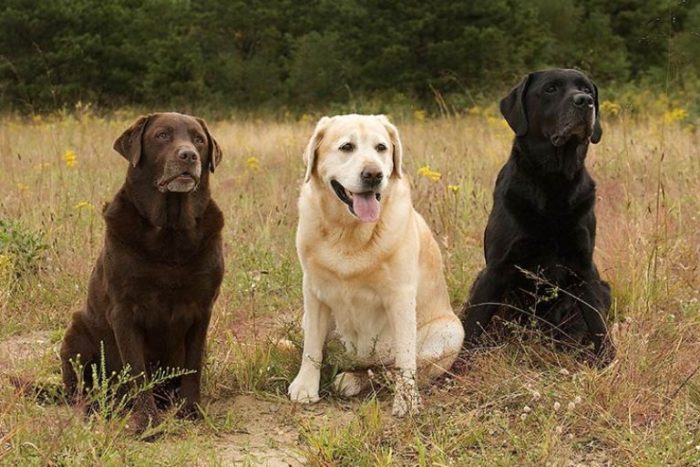The Labrador Retriever is a sweet-natured dog that functions as a hunter’s dog, search and rescue dog, therapy dog, family pet, and many more. The pup comes in three distinct coat colors comprising of yellow, black, and chocolate, and is distinguished by its broad head, full-length muzzle, otter tail, water repellent coat, and webbed paws that enable it to swim confidently in the water.
Pet parents who adopt Labs have to start training and socialization very early, though the dog is highly trainable. They can also live comfortably in a multi-pet household comprising of dogs and other pets like cats.
Table of Contents
Origin Of The Labrador Retriever
The breed’s origin is traceable to Newfoundland Island, off the northeastern Atlantic coast of Canada. Labrador Retrievers were originally known as St. John’s dogs, named after Newfoundland’s capital city. Labs were used as helpers and companions to the local fishermen from the 1700s. The pup was a working dog by the day, retrieving escaping fish for their fishermen masters and during the evenings, it spends time with its master’s family at home.
Though its heritage has remained unknown to date, it is believed that the Lab was created from crossing the Newfoundland dog, St. John’s dog, in addition to several other small-bodied local water dogs. When the dog’s good disposition and usefulness were first noticed, it was shipped into England by English sportsmen to function as hunter’s retrievers. Among the first to import St. John’s dogs into England was the second Earl of Malmesbury around 1830. The pup was first called a Labrador by the third Earl of Malmesbury.
Around the 1880s, the breed almost went into extinction after the government of Newfoundland restricted dog ownership to one per family and placing a high tax on female dogs. This led owners to cull their female puppies from the litter. The breed was saved from extinction, thanks to the Malmesbury family and several other English fans of the Labrador Retriever, and today, it is regarded as the most popular dog in America. Labs gained the recognition of the Kennel Club in England in 1903 and in 1917, it was recognized by the American Kennel Club. In the 20s and 30s, there was massive importation of British Labs in the US, establishing the breed in all of America
Things To Know About The Overall Wellbeing Of The Labrador Retriever
Health
With a longevity range of 10 to 12 years, the Labrador Retriever is classified as a healthy breed. However, people who adopt them as household pets should be aware of the health conditions that are common among the breed. They include diseases like hip dysplasia, epilepsy, heart disorders like tricuspid valve dysplasia (TVD), cataracts, hereditary myopathy (muscle weakness), progressive retinal atrophy, exercise-induced collapse (EIC), bloat, ear infections, hot spots—or acute moist dermatitis, and many more
Feeding
For an adult Lab, how much food it can consume is dependent on its size, age, activity level, weight, metabolism rate, and more. However, recommendations suggest that pet parents should feed the dog 2.5 to three cups of high-quality kibble divided into two meals morning and night. Free-feeding is not advisable to guard against wastage and overweight.
Physical Traits

Physical features of a Labrador Retriever include a broad head with features best described as “chiseled” but softened by a pair of soft ear flaps and kind expressions. The muzzle is full-length with a strong set of jaws housing 42 teeth. Its build is described as muscular and powerful with a dense otter-tailed tapered to a point.
The officially recognized coat colors for the Lab are black, yellow, and chocolate, the terms “Fox Red Labrador” and “Golden Labrador” are merely variations of the yellow Lab. Besides, the coat is double but short and water-resistant, and the Lab feels at home swimming in the water. With its strong webbed paws, it can go really low into the water.
Height-wise, the male can go up to 22.5-24.5 inches and 65-80 pounds in weight, while the female weighs 55-70 pounds and can grow up to 21.5-23.5 inches high.
Exercise & Training
Labs are known to be smart and highly energetic, thus, pet owners must provide them with the right amount of physical and mental stimulation. Two hours of daily exercise wouldn’t be a bad idea and be sure to throw in some swimming gigs, a game of fetch, and daily walks. However, you should guard against excessive vigorous activities as the Labrador is susceptible to bone problems at the puppy stage.
Training for your pup should commence at the puppy stage or immediately you take the dog home; this ensures that you can safely let them off the leash. The dog loves attention and enjoys playing games with its human family. Pet parents should also provide their Labs with safe chewing toys as the pup is happiest when it has something to gnaw on.
Temperament
Being a highly trainable dog, the Labrador Retriever can easily adapt to people and situations. Its eager to please disposition gives the dog a balanced and pleasant temperament. The Lab’s kind facial expression is a testament to its amiable nature. People who have Labs would attest that they are tolerant, easy-going and ready to mingle. However, it sometimes displays poor temperament like nervousness and aggression, but not too often.
Shedding Level
Don’t be deceived by the short hair of the Lab, the dog does shed, albeit averagely. Heavy shedding occurs two times yearly – three weeks during the fall as its summer coat transforms into a winter coat and three weeks during the spring as its thick winter coat makes the transition into a cooler summer coat. Shedding is also observed all year round but not as much as fall and spring.
Grooming
During the dog’s heavy shedding periods, daily brushing becomes compulsory to remove dead hair and prevent matting. A good quality vacuum cleaner can also do the trick. Baths can come once in two months except when the dog rolls in the mud or smelly stuff. Tatar build-ups can be removed through daily brushing of the teeth, but when it is not possible, two or three times a week will do; this keeps dental disease and bad breath at bay.
Trimming for the nails should be done once or twice monthly and weekly checks should be conducted in the ears for signs of bad odor or redness; these are indications of infections. The outer ears can be wiped with cotton balls moistened with mild, pH-balanced ear cleaner when dirty.
Grooming should start from the puppy stage and pet parents should handle their dog’s paws as frequently as possible since dogs are known to be touchy about their paws. Try to make grooming a positive experience for your pooch filled with loads of treats, praises, and rewards. This lays a good foundation for future vet checkups at the adult stage.
Read Also: 10 Smartest Dog Breeds: These Dogs Are Regarded As Intelligent
Labrador Retriever Among Children and Other Pets
The Labrador Retriever breed doesn’t just love children, they also enjoy all the accompanying commotions. A Lab would happily participate in a kid’s birthday party and may even be willing to wear a party hat. However, you need to socialize the dog on how to relate with kids and on the other hand, the kids should be trained on how to relate with dogs. For one, they should never approach a sleeping dog nor disturb the pup’s mealtime. Secondly, making away with a dog’s food is asking for trouble and they can get bitten for it. Pulling of ear and tail should be prohibited and any interactions with very little kids must be supervised.
Labs Are Friendly With Other Pets
You can go ahead and rear your Labrador Retriever in a multi-pet home as the breed is known to be tolerant of other dogs. Besides, it can also co-habit with other household pets like cats but they must be properly socialized for the arrangement to work effectively.
They Make Great Family Dogs
Labrador Retrievers are famously friendly and any friendly dog is good for the family. In fact, the breed has been aptly described as a companionable housemate that loves to bond with every member of the family. Labs can even extend their hands of friendship to their neighbors, both humans, and animals.
Devotion to the Labradors runs very deep, this people-oriented dog can do a lot for their family. Fans of the Labs have likened the breed to angels because of their amiable nature
